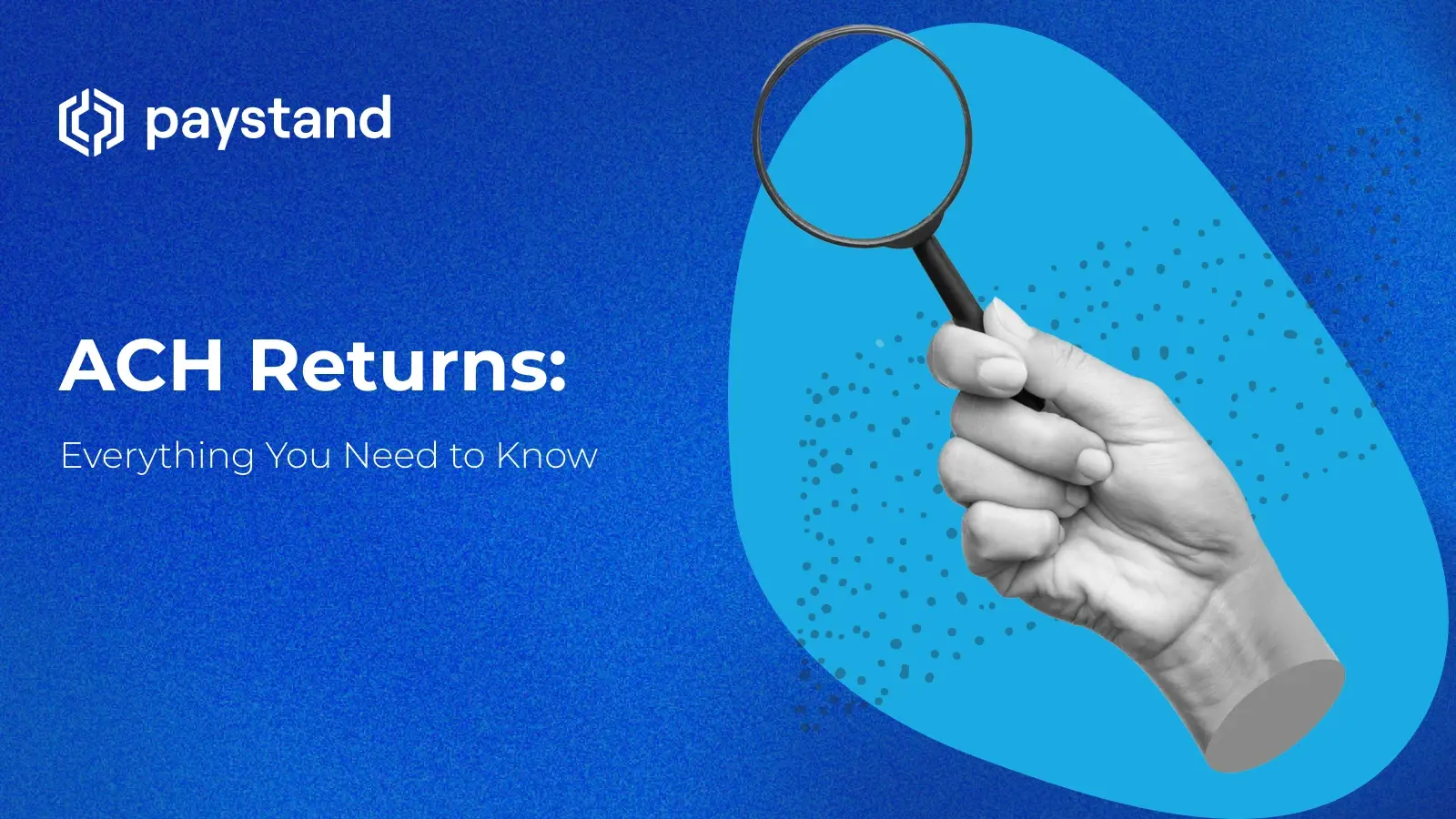ACH Returns: Everything You Need to Know

Table of Contents
- What does ach return mean?
- ACH returns through the payment lifecycle
- What do the most common ACH return codes mean?
- How long does an ACH return take?
- Are there fees associated with ACH returns?
- How to reduce ACH returns
- How to handle ACH returns: best practices for finance teams
- Preventing ACH returns before they start
- ACH returns and the shift toward smarter payments
Key Takeaways
- Merchant acquirers play a crucial yet overlooked role in card payment processing, but their outdated systems can undermine operational efficiency and cash flow.
- Traditional acquiring models suffer from hidden fees, slow settlements, and fragmented infrastructures, rendering them unsuitable for modern B2B finance needs.
- Finance teams must differentiate between merchant acquirers and payment processors and assess their integration with tech stack and automation goals.
- New solutions like blockchain platforms and zero-fee networks redefine payment processing by eliminating intermediaries and improving speed, transparency, and control.
In today’s payment landscape, where speed, automation, and transparency are vital, ACH transfers remain a quiet workhorse, moving trillions annually across the U.S. financial system. But even this well-oiled machine has its vulnerabilities. The fallout is called an ACH return when an ACH payment fails midstream. And for finance leaders tasked with preserving cash flow and operational efficiency, these returns aren’t just minor hiccups, but system-wide disruptions hiding in plain sight.
In a world chasing real-time payment perfection, ACH returns are a stubborn reminder that even digital rails aren’t immune to error. Understanding how these failures work isn't optional if you're a CFO, controller, or AR leader. It’s essential to future-proof your revenue engine.
What Does ACH Return Mean?
An ACH return happens when a bank-to-bank electronic payment isn’t completed and is sent back to the ACH originator. While the ACH system is designed for reliability and cost-efficiency, it’s not foolproof. When a return occurs, it’s the financial equivalent of a “delivery failed” notice.
Returns happen for many reasons, technical and behavioral. The recipient’s account might be closed, their balance might be too low, the account number might be off by one digit, or the customer might have revoked payment authorization altogether.
For businesses, that means delayed revenue, disrupted cash flow, and hours spent untangling the knot. It’s more than a transaction gone wrong; it’s a drag on your entire receivables process. And because ACH failures aren’t always detected in real-time, they can surprise you days after you thought a payment was in the clear.
ACH Returns Through the Payment Lifecycle
Understanding ACH returns involves tracing a payment's path. An ACH transaction begins with the Originating Depository Financial Institution (ODFI), which sends payment instructions to the ACH network. It then moves to the Receiving Depository Financial Institution (RDFI), which processes the recipient's account.
If the recipient's account is closed, the routing number is invalid, or the customer did not authorize the payment, the RDFI may reject the transaction. A return code is issued in such cases, and funds are returned to the originator’s account. Though invisible to most customers, this process is not harmless to AR teams.
ACH returns aren’t instant; it may take days for businesses to learn about transaction failures, disrupting forecasting and causing cascading payment delays. These timing lags are particularly harmful for subscription-based or milestone-driven payments, where cash flow precision is essential.
The operational impact compounds quickly: finance teams must reprocess transactions, inform stakeholders, communicate with customers, and start remediation. Late payments skew DSO metrics and distort working capital visibility. One ACH return can disrupt industries with recurring payments or large transactions.
Some businesses have adopted automated return tracking tools and machine learning-based exception management systems to reduce manual intervention and flag patterns in customer accounts. These tools enable real-time decision-making, freeing AR teams from reactive fire drills and allowing proactive payment health monitoring. Understanding where returns occur in the payment lifecycle enhances your ability to predict and prevent them.
What Do the Most Common ACH Return Codes Mean?
ACH return codes are diagnostic tools that help explain why a payment failed. Understanding them helps businesses fix the issue at hand and prevent similar problems.
- R01 - Insufficient Funds: The account lacked sufficient funds, often indicating that the customer was unaware of the debit. It's essential to revisit payment timing and communication.
- R02 - Account Closed: The recipient closed the account before the payment landed. This suggests outdated customer data or a lapse in verifying account status.
- R03 - No Account/Unable to Locate Account: The account information doesn’t match RDFI records. This return code often indicates poor payment validation controls due to data entry issues.
- R04 - Invalid Account Number: Formatting or data entry issues caused the bank to reject the account number. Account validation tools can largely prevent this error.
- R07 - Authorization Revoked by Customer: The customer canceled the authorization. This occurs when a misunderstanding or dispute signals the need for better customer onboarding and agreement tracking.
- R10 - Customer Advises Not Authorized: The customer disputes the payment entirely. If not handled properly, this can lead to chargebacks or legal issues, often indicating deeper trust or process breakdowns.
Understanding these codes isn't just for compliance. They're a mirror to your AR system’s health. Repeated codes can reveal systemic issues, from outdated customer data to authorization missteps. And when left unresolved, these issues lead to more returns, fees, and resource strain on your finance team.
Tracking return codes can inform strategic decisions. For instance, a high volume of R03 or R04 returns may indicate a need to overhaul onboarding or validation processes. A spike in R07 or R10 returns might suggest trust issues or potential fraud, requiring a review of payment authorization processes.
How Long Does an ACH Return Take?
Most ACH returns are processed within two business days of the original transaction. However, the actual timeframe depends on the return reason code. For example, returns related to unauthorized transactions (like R07 or R10) can be initiated within 60 calendar days, meaning your business might not see the red flag until weeks later.
This delay hampers cash visibility, complicating accurate forecasting and confident reporting. The impact worsens if staffing is lean or there are many daily transactions. Each day a payment remains unresolved skews metrics like DSO and influences your CFO's assessment of working capital efficiency.
Finance teams use real-time notifications for failed payments, ideally integrated into their payment portal or ERP. Automation alerts the customer, prompts the AR team, and seamlessly reinitiates the payment.
Are There Fees Associated With ACH Returns?
Like a bounced check, ACH returns incur a fee that your bank or payment processor charges. While these fees may appear small (often $2 to $10 per transaction), they can accumulate quickly in high-volume fields like healthcare, where recurring B2B payments are common.
More importantly, fees aren’t just financial. There’s also the operational cost of investigating the error, coordinating with customers, and reprocessing the payment. For businesses with manual payment systems, this can eat up weekly hours and lead to burnout in AR teams.
Payment automation leverages AI for exception handling and automated return resolution, allowing companies to reduce manual follow-up time and costs significantly. With Paystand, these tools integrate seamlessly into existing ERP or payment workflows, enabling teams to resolve issues without switching systems.
How to Reduce ACH Returns
ACH returns aren't inevitable. In fact, with the right tech stack and process optimization, most are preventable. Here’s how to fight back:
-
Verify account info before sending funds: Use real-time payment verification tools that validate routing and account numbers.
-
Keep customer data fresh: Build systems to confirm and update account information regularly. Automate reminders or embed validation in onboarding.
-
Automate return resolution: Platforms like Paystand flag and classify returns instantly, so your team isn’t buried in spreadsheets or endless bank statements.
-
Educate your customers: Many returns result from misunderstandings. Clarify ACH authorization requirements and help customers stay compliant.
How to Handle ACH Returns: Best Practices for Finance Teams
If your payment gets returned, act quickly. Here’s a modern playbook for ACH return resolution that aligns with B2B best practices and today’s digital-first finance operations:
-
Review the return code: The return code explains what went wrong and informs the next step, whether it’s contacting the customer, validating bank details, or pausing future transactions.
-
Validate payment information: Confirm account numbers, routing codes, and authorization details before retrying the transaction. Use bank verification tools or KYC-compliant onboarding to minimize errors.
-
Communicate transparently: Notify the customer promptly. Automated alerts reduce confusion and build trust, especially for sensitive payments like healthcare claims or large invoices.
-
Update records and automate the retry: Once resolved, your system should automatically reinitiate the payment with updated information and a timestamped audit trail for compliance.
-
Monitor for patterns: ACH returns aren’t random. By using machine learning to identify repeat offenders and suspicious trends, you can stay ahead and adjust your strategy proactively.
Preventing ACH Returns Before They Start
Prevention begins with onboarding, invoice delivery, and authorization capture. Fragmented financial processes increase return risk. Centralizing your AR workflow with a healthcare payment automation platform or zero-fee payment gateway enhances control. Here’s how proactive businesses reduce ACH return risk:
- Pre-authorization verification: Automatically check routing and account numbers against national databases to prevent input errors before submission.
- Real-time funds verification: Some advanced platforms can check for sufficient funds before initiating a debit, helping avoid R01 returns.
- Secure digital payment portals: Offering customers a self-service experience reduces disputes and missed payments.
- Integrated Terms Management: Display payment terms, authorization language, and due dates at every customer touchpoint.
ACH Returns and the Shift Toward Smarter Payments
ACH returns might feel like a legacy problem, but how you handle them signals how modern your finance function is. In a business world moving rapidly toward digitization, blockchain payments, smart controls, paper checks, and reactive payment management just don’t cut it anymore.
Finance leaders today need more than spreadsheets and notifications; they need insight. That’s where platforms like Paystand provide a massive edge.
Paystand combines blockchain technology, AR automation, and ERP-embedded payments to create a fully automated, zero-fee payment experience. It eliminates return risk at the root by:
- Verifying account data before a transaction occurs
- Enabling real-time payment tracking and resolution
- Automatically flagging suspicious return behavior
- Providing a digital payment portal for recurring B2B payments
- Eliminating per-transaction fees with a subscription-based model
In other words: fewer returns, faster resolution, and radically better cash flow.
The Bottom Line: Returns Don’t Have to Be a Roadblock
ACH returns are a natural byproduct of digital payments, but they don’t have to slow you down. With the right tools and strategies, finance teams can turn return data into a diagnostic advantage, identifying systemic issues before they spiral.
By adopting smarter, automated payment infrastructure, businesses don’t just avoid the next R01 or R07; they build a financial system that’s future-proof, fraud-resistant, and designed for growth.
If your finance stack still treats returns as manual to-do items instead of solvable signals, it’s time to rethink your approach. Learn how Paystand’s modern AR solution can help you reduce risk, eliminate fees, and regain control of your cash flow—starting now.





